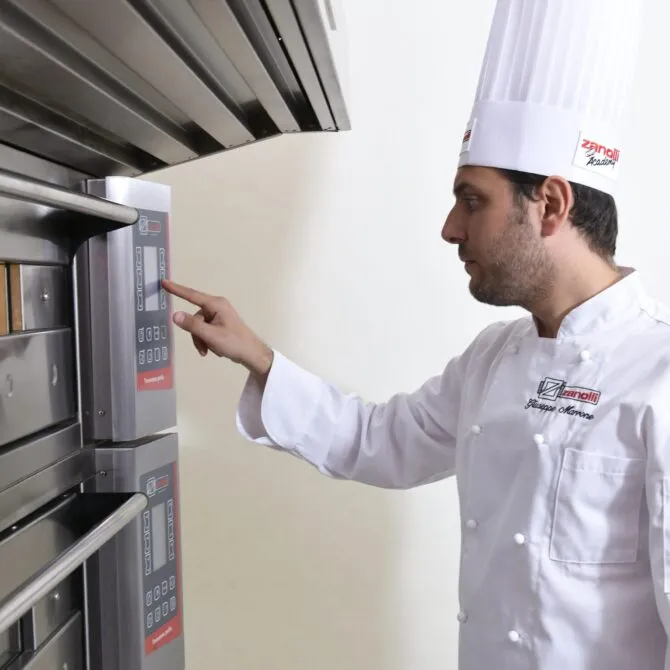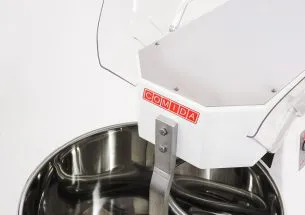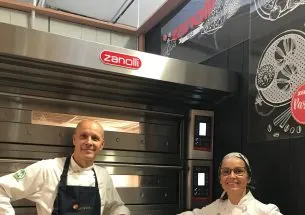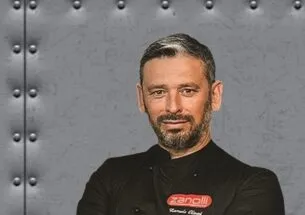
Giuseppe Marrone, teacher and consultant in pastry and ice cream, revealed to us his vision on ways to reduce wastage and contain costs in making confectionery. Zanolli Discovery shares it with you.
What methods for ingredients do you recommend to avoid waste?
Giuseppe Marrone: I suggest first preventing wastage upstream, plan production on a realistic basis. The choice of the recipes is essential, in my opinion you should temper creative ambitions with a bit of healthy pragmatism, without bridling your own inspiration. It is good that the recipes, although different, will talk to each other through common bases, passages and processes, to avoid wastage of not only material but also of time and resources. Everything counts in food cost!
Can you reuse production waste?
GM: Fortunately, there are virtuous solutions. Sponge cake for example can be crumbled and integrated into the mix to produce cantuccini. Often it is tradition that teaches!
Can freezing the products help? Does the quality remain same?
GM: Freezing in various ways can certainly help professionals. The ideal process involves vacuum packing, blast chilling and freezing. Blast chilling brings the product around to – 18°C, which is essential to ensure flavour and active ingredients. You should carefully consider the quantity and quality of sugar in the product that you want to freeze. I recommend being well informed and using sugar in moderation, because it can also have anti-freeze properties. If the confectioner follows procedures correctly, taking care for example to avoid water in the products to be frozen, then when defrosted the food will rediscover its organoleptic properties.
For the ovens and equipment, what advice can you give to maximise energy savings?
GM: I recommend rationalising the baking: fill the oven as much as possible – within the oven’s capacity – to avoid frequent baking. Also, take care to arrange the products regularly on the tins to encourage cooking uniformity. A standby function can be useful in ovens. Take care of cleanliness, check the nozzles are not clogged…these are all measures which benefit in the long run! It is extremely important to choose, to understand and know how to make the best use of your own instruments, whether machines or tools.

Is the concept of zero km exploited in pastry? How does it harmonize with the continuous search for originality and experimentation?
GM: It is a complex topic to fully explore. Only in artisan production can we use ingredients classified as zero Km. In extreme cases, there is also a self-production. For some basic ingredients such as milk and eggs, this is feasible, for flour it’s more complicated. The same labels of ‘bio’ and ‘zero km’ should be taken with a pinch of salt… In pastry, I speak especially of Italy, we note a certain territorial contamination which I am not against, indeed. It is not a phenomenon that can be controlled, so it is worth accepting, although maintaining a certain level of requirement for traditional procedures. The public is not reluctant to consume a Sicilian cannolo in Milan, but is more heartened if they know that the pastry chef comes from Sicily. Many pastry products are also extremely connected to territorial products. To get certain ingredients, the pastry chef who likes to wander in the tastes of every region must necessarily contravene the principle of zero Km.
Is there a chain for recovering waste and unsold, or expired edible food in the world of pastry?
GM: There used to be one, but recent sanitary standards have imposed restrictions in this sense. In both schools and pastry shops, the finished product should not be sold to third parties and taken away freely. Especially for products that contain allergens, controls are rigid. These rules that protect consumers can have an undesired effect when many surpluses must be thrown away. For this very reason, it is of the uttermost importance to think out the production line from the outset.
Attention to reducing waste and to respecting the environment can also be an economic benefit or for pastry shops it is more comfortable and less onerous to use ordinary methods?
GM: A lot depends on the complexity of the recipes, but often respecting the environment unfortunately takes second place to the imperative of profits. The ecological footprint must be determined when designing the pastry line. Certain virtuous methodologies often remain within the scope of personal ethics because correctly arranging certain waste materials – such as oils – involves cumbersome procedures that few choose to undertake. Many operators instead have no qualms about giving a ‘green’ twist just to their own communication, without a real change in production methods.
So there is a glimmer of optimism?
GM: I believe that, for any profession, training is very important. For the pastry shop, training generally includes notions that are also important for food cost, and consequently this can be a further incentive to holistically plan production. There are fortunately also teachers who teach how to make processes leaner and therefore less chaotic. We can find another good example of optimisation in the trend in pastry making to specialisation in one or a few products. As long as it remains artisan, this approach may prove successful.


Giuseppe Marrone, teacher and consultant in pastry and ice cream, revealed to us his vision on ways to reduce wastage and contain costs in making confectionery. Zanolli Discovery shares it with you.
What methods for ingredients do you recommend to avoid waste?
Giuseppe Marrone: I suggest first preventing wastage upstream, plan production on a realistic basis. The choice of the recipes is essential, in my opinion you should temper creative ambitions with a bit of healthy pragmatism, without bridling your own inspiration. It is good that the recipes, although different, will talk to each other through common bases, passages and processes, to avoid wastage of not only material but also of time and resources. Everything counts in food cost!
Can you reuse production waste?
GM: Fortunately, there are virtuous solutions. Sponge cake for example can be crumbled and integrated into the mix to produce cantuccini. Often it is tradition that teaches!
Can freezing the products help? Does the quality remain same?
GM: Freezing in various ways can certainly help professionals. The ideal process involves vacuum packing, blast chilling and freezing. Blast chilling brings the product around to – 18°C, which is essential to ensure flavour and active ingredients. You should carefully consider the quantity and quality of sugar in the product that you want to freeze. I recommend being well informed and using sugar in moderation, because it can also have anti-freeze properties. If the confectioner follows procedures correctly, taking care for example to avoid water in the products to be frozen, then when defrosted the food will rediscover its organoleptic properties.
For the ovens and equipment, what advice can you give to maximise energy savings?
GM: I recommend rationalising the baking: fill the oven as much as possible – within the oven’s capacity – to avoid frequent baking. Also, take care to arrange the products regularly on the tins to encourage cooking uniformity. A standby function can be useful in ovens. Take care of cleanliness, check the nozzles are not clogged…these are all measures which benefit in the long run! It is extremely important to choose, to understand and know how to make the best use of your own instruments, whether machines or tools.

Is the concept of zero km exploited in pastry? How does it harmonize with the continuous search for originality and experimentation?
GM: It is a complex topic to fully explore. Only in artisan production can we use ingredients classified as zero Km. In extreme cases, there is also a self-production. For some basic ingredients such as milk and eggs, this is feasible, for flour it’s more complicated. The same labels of ‘bio’ and ‘zero km’ should be taken with a pinch of salt… In pastry, I speak especially of Italy, we note a certain territorial contamination which I am not against, indeed. It is not a phenomenon that can be controlled, so it is worth accepting, although maintaining a certain level of requirement for traditional procedures. The public is not reluctant to consume a Sicilian cannolo in Milan, but is more heartened if they know that the pastry chef comes from Sicily. Many pastry products are also extremely connected to territorial products. To get certain ingredients, the pastry chef who likes to wander in the tastes of every region must necessarily contravene the principle of zero Km.
Is there a chain for recovering waste and unsold, or expired edible food in the world of pastry?
GM: There used to be one, but recent sanitary standards have imposed restrictions in this sense. In both schools and pastry shops, the finished product should not be sold to third parties and taken away freely. Especially for products that contain allergens, controls are rigid. These rules that protect consumers can have an undesired effect when many surpluses must be thrown away. For this very reason, it is of the uttermost importance to think out the production line from the outset.
Attention to reducing waste and to respecting the environment can also be an economic benefit or for pastry shops it is more comfortable and less onerous to use ordinary methods?
GM: A lot depends on the complexity of the recipes, but often respecting the environment unfortunately takes second place to the imperative of profits. The ecological footprint must be determined when designing the pastry line. Certain virtuous methodologies often remain within the scope of personal ethics because correctly arranging certain waste materials – such as oils – involves cumbersome procedures that few choose to undertake. Many operators instead have no qualms about giving a ‘green’ twist just to their own communication, without a real change in production methods.
So there is a glimmer of optimism?
GM: I believe that, for any profession, training is very important. For the pastry shop, training generally includes notions that are also important for food cost, and consequently this can be a further incentive to holistically plan production. There are fortunately also teachers who teach how to make processes leaner and therefore less chaotic. We can find another good example of optimisation in the trend in pastry making to specialisation in one or a few products. As long as it remains artisan, this approach may prove successful.

You might also be interested in...





